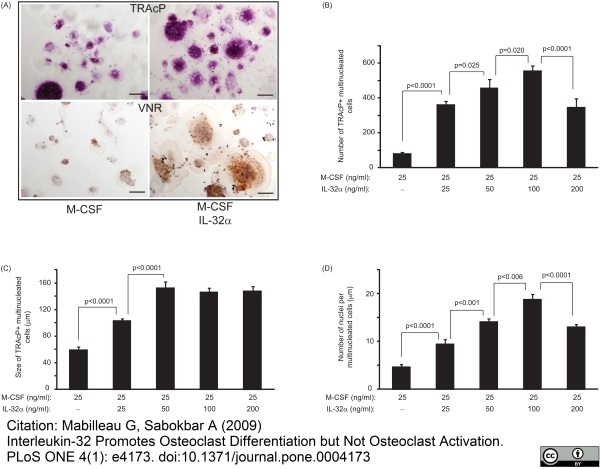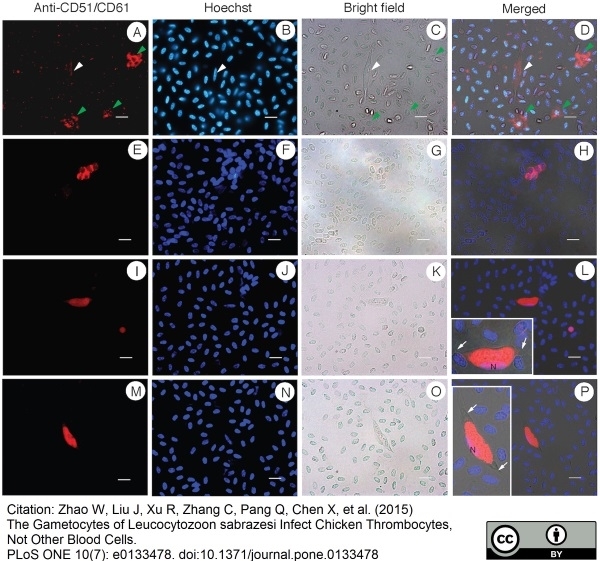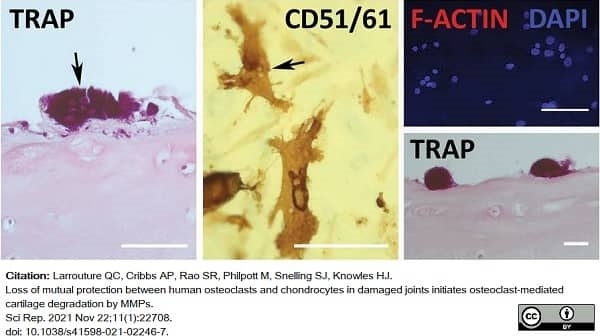CD51/CD61 antibody | 23C6



Mouse anti Human CD51/CD61
- Product Type
- Monoclonal Antibody
- Clone
- 23C6
- Isotype
- IgG1
- Specificity
- CD51/CD61
| Mouse anti Human Cd51/CD61 antibody, clone 23C6 recognizes the intact complex formed between the CD51 and CD61 molecules (alpha V and beta 3 integrins). This complex binds vitronectin at the RGD sequence and can also bind fibrinogen, von Willebrand factor, thrombospondin, fibronectin, osteopontin and collagen. Mouse anti Human CD51/CD61 antibody, clone 23C6 reacts with osteoclasts, placenta, melanoma cell lines and weakly with platelets. |
- Target Species
- Human
- Species Cross-Reactivity
-
Target Species Cross Reactivity Bovine Pig Chicken - N.B. Antibody reactivity and working conditions may vary between species.
- Product Form
- Purified IgG - liquid
- Preparation
- Purified IgG prepared by affinity chromatography on Protein A from tissue culture supernatant
- Buffer Solution
- Phosphate buffered saline
- Preservative Stabilisers
0.09% Sodium Azide - Carrier Free
- Yes
- Immunogen
- Osteoclasts from osteoclastomas.
- Approx. Protein Concentrations
- IgG concentration 1.0 mg/ml
- Fusion Partners
- Spleen cells from immunized mice were fused with cells of the mouse X63.Ag8.653 myeloma cell line.
- Regulatory
- For research purposes only
- Guarantee
- 12 months from date of despatch
Avoid repeated freezing and thawing as this may denature the antibody. Storage in frost-free freezers is not recommended.
| Application Name | Verified | Min Dilution | Max Dilution |
|---|---|---|---|
| Flow Cytometry | 1/40 | 1/80 | |
| Immunofluorescence | |||
| Immunohistology - Frozen 1 | |||
| Immunohistology - Paraffin | |||
| Immunoprecipitation |
- 1The epitope recognised by this antibody is reported to be sensitive to formaldehyde fixation and tissue processing. Bio-Rad recommends the use of acetone fixation for frozen sections.
- Flow Cytometry
- Use 10ul of the suggested working dilution to label 106 cells in 100ul.
| Description | Product Code | Applications | Pack Size | List Price | Your Price | Quantity | |
|---|---|---|---|---|---|---|---|
| Mouse IgG1 Negative Control | MCA928 | F | 100 Tests |
|
Log in | ||
| List Price | Your Price | ||||||
|
|
Log in | ||||||
| Description | Mouse IgG1 Negative Control | ||||||
References for CD51/CD61 antibody
-
Horton, M.A. et al. (1985) Monoclonal antibodies to osteoclastomas (giant cell bone tumors): definition of osteoclast-specific cellular antigens.
Cancer Res. 45 (11 Pt 2): 5663-9. -
Davies, J. et al. (1989) The osteoclast functional antigen, implicated in the regulation of bone resorption, is biochemically related to the vitronectin receptor.
J Cell Biol. 109 (4 Pt 1): 1817-26. -
Simpson, A. & Horton, M.A. (1989) Expression of the vitronectin receptor during embryonic development; an immunohistological study of the ontogeny of the osteoclast in the rabbit.
Br J Exp Pathol. 70 (3): 257-65. -
Danks, L. et al. (2002) Synovial macrophage-osteoclast differentiation in inflammatory arthritis.
Ann Rheum Dis. 61: 916-21. -
Lau, Y.S. et al. (2006) Malignant melanoma and bone resorption.
Br J Cancer. 94: 1496-503. -
Viertlboeck, B.C, and Göbel, T.W. (2007) Chicken thrombocytes express the CD51/CD61 integrin.
Vet Immunol Immunopathol. 119:137-41. -
Lau, Y.S. et al. (2007) Cellular and humoral mechanisms of osteoclast formation in Ewing's sarcoma
Br J Cancer. 96: 1716-22. -
Mabilleau, G. et al. (2009) Interleukin-32 promotes osteoclast differentiation but not osteoclast activation.
PLoS One. 4:e4173.
View The Latest Product References
-
Whyte, L.S. et al. (2009) The putative cannabinoid receptor GPR55 affects osteoclast function in vitro and bone mass in vivo.
Proc Natl Acad Sci U S A. 106: 16511-6. -
Knowles, H.J. et al. (2010) Hypoxia-inducible factor regulates osteoclast-mediated bone resorption: role of angiopoietin-like 4.
FASEB J. 24: 4648-59. -
Coxon, F.P. et al. (2012) Isolation and purification of rabbit osteoclasts.
Methods Mol Biol. 816: 145-58. -
Iseri, V.J. & Klasing, K.C. (2013) Dynamics of the systemic components of the chicken (Gallus gallus domesticus) immune system following activation by Escherichia coli; implications for the costs of immunity.
Dev Comp Immunol. 40 (3-4): 248-57. -
Zhao W et al. (2015) The Gametocytes of Leucocytozoon sabrazesi Infect Chicken Thrombocytes, Not Other Blood Cells.
PLoS One. 10 (7): e0133478. -
Knowles, H.J. (2017) Hypoxia-Induced Fibroblast Growth Factor 11 Stimulates Osteoclast-Mediated Resorption of Bone.
Calcif Tissue Int. 100 (4): 382-91. -
Larrouture, Q.C. et al. (2021) Loss of mutual protection between human osteoclasts and chondrocytes in damaged joints initiates osteoclast-mediated cartilage degradation by MMPs.
Sci Rep. 11 (1): 22708. -
Kim, J.S. et al. (2021) Randomization to Omega-3 Fatty Acid Supplementation and Endothelial Function in COPD: The COD-Fish Randomized Controlled Trial.
Chronic Obstr Pulm Dis.8(1): 41-53.
- Synonyms
- Vitronectin Receptor
- RRID
- AB_321468
- UniProt
- P06756
- P05106
- Entrez Gene
- ITGB3
- ITGAV
- GO Terms
- GO:0001938 positive regulation of endothelial cell proliferation
- GO:0002576 platelet degranulation
- GO:0050839 cell adhesion molecule binding
- GO:0004872 receptor activity
- GO:0005161 platelet-derived growth factor receptor binding
- GO:0008305 integrin complex
- GO:0007160 cell-matrix adhesion
- GO:0007229 integrin-mediated signaling pathway
- GO:0007411 axon guidance
- View More GO Terms
- GO:0042802 identical protein binding
- GO:0010595 positive regulation of endothelial cell migration
- GO:0010745 negative regulation of macrophage derived foam cell differentiation
- GO:0010888 negative regulation of lipid storage
- GO:0014909 smooth muscle cell migration
- GO:0030168 platelet activation
- GO:0030949 positive regulation of vascular endothelial growth factor receptor signaling pathway
- GO:0031092 platelet alpha granule membrane
- GO:0032147 activation of protein kinase activity
- GO:0032369 negative regulation of lipid transport
- GO:0035295 tube development
- GO:0043184 vascular endothelial growth factor receptor 2 binding
- GO:0044419 interspecies interaction between organisms
- GO:0045124 regulation of bone resorption
- GO:0045715 negative regulation of low-density lipoprotein particle receptor biosynthetic process
- GO:0050731 positive regulation of peptidyl-tyrosine phosphorylation
- GO:0050748 negative regulation of lipoprotein metabolic process
- GO:0050900 leukocyte migration
- GO:0060055 angiogenesis involved in wound healing
- GO:0071062 alphav-beta3 integrin-vitronectin complex
- GO:0005515 protein binding
- GO:0007596 blood coagulation
MCA757G
MCA757GA
If you cannot find the batch/lot you are looking for please contact our technical support team for assistance.
Please Note: All Products are "FOR RESEARCH PURPOSES ONLY"
View all Anti-Human ProductsAlways be the first to know.
When we launch new products and resources to help you achieve more in the lab.
Yes, sign me up

